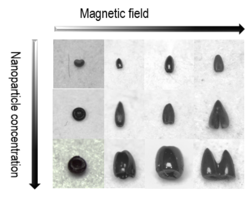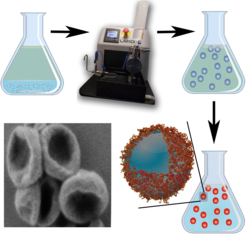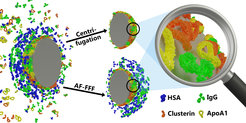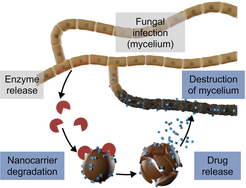
Max Planck Twente Center for Complex Fluid Dynamics
From colloidal fluids to functional materials

Max Planck-University of Twente Center is a research network dedicated to the complexities of fluid dynamics. The fundamental knowledge in this interdisciplinary topic is relevant for numerous fields, such as sustainable energy, medical lab-on-a-chip systems or climate. The focus of the Landfester group within the Max Planck Twente Center is on understanding the dynamics of multiphase fluids containing colloids, which will provide knowledge currently missing for applications in material science. We address different questions in self-assembly or microfabrication of colloidal fluids to link the properties of single colloids to their behavior in fluids and to tailor the properties of the resulting materials.
Supraparticles by drying ferrofluid droplets

Superparamagnetism exists only in nanocrystals, and thus superparamagnetic nanoparticles have to assemble into complex structures to endow superparamagnetic materials. Most techniques to produce such assemblies are inefficient in terms of time and material. We used evaporation-guided assembly to produce superparamagnetic supraparticles. By tuning the concentration of ferrofluid droplets and the magnetic field, we obtained superparamagnetic supraparticles with different structures. This approach is universal and can be extended to design materials with higher complexity integrating other colloids. We used the magnetic and anisotropic nature of the resulting supraparticles to prepare magnetically actuable microswimmers.
Controlled nanoparticle production by microfluidization

Polymer nanocarriers are used as transport modules in the next generation of drug delivery technology. The performance of nanoscaled drug carriers strongly depends on their physicochemical characteristics. Therefore, the success of new nanocarriers strongly depends on our ability to precisely control their synthesis on a large scale. Until recently both fundamental and translational studies have been hampered by the difficulty of using the current methods to produce monodispersed nanocarriers in large quantities and with high reproducibility. We have developed a versatile and scalable approach for the large-scale synthesis of polymer nanocarriers from water-in-oil miniemulsions using microfluidization to achieve a controlled emulsification. This method was proven to be effective to prepare nanocarriers with different biopolymers, to include polysaccharides, lignin, proteins, with yields up to 43 g min−1 with reproducible size and size distribution.
Particles in blood flow

When nanocarriers that are used for drug delivery come in contact with biological fluids, proteins will adsorb to the nanocarriers’ surface to form the protein corona. To make nanomedicine safe and reliable it is required to get a better insight into protein corona. We have introduced the asymmetric flow field-flow fractionation (AF4) as a new separation technique. With AF4 we could separate nanoparticles including not just a hard corona with strongly bound proteins, but also with the soft protein corona with loosely bound proteins for further characterization. With this, we were able to show that only the hard protein corona directly influenced the cell uptake behavior.
Flow in plants

Fungal plant diseases require spraying a fungicide, which lead to environmental damage. Here we used flow in plant trunks to develop the first nanocarrier‐mediated drug delivery in plants. Enzyme‐degradable lignin nanocarriers are injected into the trunks of grapevine plants. They release a fungicide selectively inside of the plants and are able to cure the worldwide fungal plant disease Esca for the first time. This strategy will reduce the extensive spraying of pesticides in agriculture.




